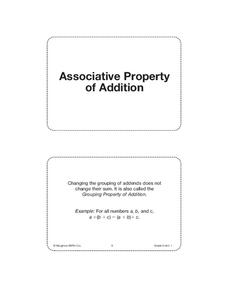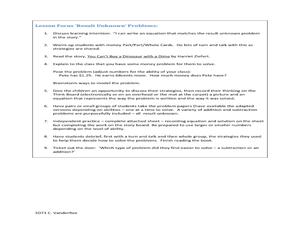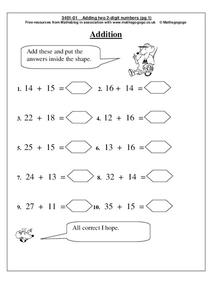Curated OER
10 More or 10 Less
Practice adding and subtracting 10 with this outer space worksheet. On the top, scholars match digits floating in stars with sums inside a spaceship. Next, they do the same with subtracting 10, connecting numbers to differences. These...
Curated OER
Arithmetic Patterns
When one number goes in, another comes out. Scholars are introduced to math functions as they multiply, subtract, and divide numbers to get new ones. There are three functions and tables of numbers here; pupils apply the rule to each...
Pedago Net
Acing Math
Deal me in! Elementary and middle school classes will love this selection of math games, all involving a deck of cards. From fractions to exponents to rounding up and down, the games cover such a variety of skills that your classroom...
Curated OER
Math Games for Skills and Concepts
A 27-page packet full of math games and activities builds on algebra, measurement, geometry, fractional, and graphing skills. Young mathematicians participate in math games collaboratively, promoting teamwork and skills practice.
Curriculum Corner
Splashes of Spring Math Centers
Spring into math practice with a set of resources that taps into a variety of math practice. Skills include matching expressions to their definitions, a place value sorting activity, three multiplication and division games,...
Resources for Educators
Math & Science Connection
Whether you're using a collection of Dr. Seuss books to teach basic math skills like counting, adding, and subtracting, or exploring the different states of matter by melting a crayon with a hairdryer, a series...
Houghton Mifflin Harcourt
Unit 1 Math Vocabulary Cards (Grade 5)
Associative property of addition, exponents, and variables are a few of the terms that a set of flash cards includes and are designed to support math vocabulary instruction. Cards offer a a bold-faced font as well as a thorough...
Concord Consortium
Last Digit Arithmetic
Mathematics involves a study of patterns. The exploratory lesson has learners consider the addition pattern in different sets of numbers. Each set has a different pattern that pupils describe mathematically. The patterns involve...
Math Learning Center
Third Grade Assessments and Scoring Checklists, Common Core State Standards
How are your learners doing with place value? Track their skill levels with a set of math assessments. The packet includes worksheets to hand out to your class, scoring checklists, a calendar for implementation, and instructions for...
Math Learning Center
Second Grade Assessments and Scoring Checklists, Common Core State Standards
How are your second graders progressing in their math skills? Find out with a series of math assessment activities. With baseline assessment score sheets for each skill, you can track how well your kids are adding, subtracting, telling...
Curated OER
One Vs. One Hundred
Students explore the concept of place value. They differentiate between digits and their values as it related to addition and subtraction. Through the use of technology and manipulatives students investigate the place value of digits by...
Curated OER
Number Manipulation
In this number manipulation worksheet, students solve 4 different types of problems that include number manipulation. First, they use division, multiplication, addition, or subtraction to make each set of numbers into equations which...
Curated OER
Book Title: You Can’t Buy a Dinosaur with a Dime
Students explore the concepts of multiple digit addition and subtraction. For this addition and subtraction lesson, students read the book You Can’t Buy a Dinosaur with a Dime and then discuss methods for solving a particular math...
Curated OER
Subtraction
Second graders regroup two-digit numbers and solve advanced subtraction problems with regrouping; students use straw and cup manipulatives to demonstrate how to borrow from the tens place in order to solve the problem.
Curated OER
Make 80
In this addition worksheet, students solve 15 addition and subtraction problems using 2-digit numbers. The answers are on the second page.
Curated OER
Addition
In this addition instructional activity, 3rd graders practice solving 10 addition problems involving 2-digit whole numbers. Students put their answers in the shapes provided.
Curated OER
Casting Out Nines
Students identify division problems with no remainders. In this division lesson, students learn to decipher division problems using addition and subtraction to determine if the problem will contain a remainder.
Curated OER
Centipede's 100 Shoes
Young scholars solve equations with the help of their teacher. In this simple equations lesson, students listen to the story Centipede's 100 Shoes by Tony Ross and use the scenarios given in the book as addition and subtraction problems....
Curated OER
The School Store
Young scholars choose between the operations of addition or subtraction to solve a real life problem. In this addition and subtraction lesson, students make a chart of items sold in the school store. Young scholars then work in teams to...
Curated OER
Investigation - Who is Right?
Third graders explore mathematics by solving problems in groups. In this math functions activity, 3rd graders demonstrate their understanding of addition and subtraction by completing two digit math problems. Students define a list of...
Curated OER
Ten Cards Game
In this cards game, students play a card game in three rounds. In the first round, the student's objective is to gather the largest sum of cards. For round two, students try to gather cards to equal a sum of 50. In the...
Curated OER
Subtract 19
For this subtracting 19 worksheet, students subtract 19 from different 2 digit numbers. Students complete 18 problems where they subtract 19.
Curated OER
4-Digit Problem Solving: Add and Subtract
In this problem solving worksheet, students solve a total of 7 equations, drawing models and using algorithm. A reference web site for additional activities is given.
Curated OER
Answer Match
In this addition and subtraction practice worksheet, students solve 26 problems that require them to add and subtract using 3-digit numbers. Students match the problems that have the same sums and differences.























